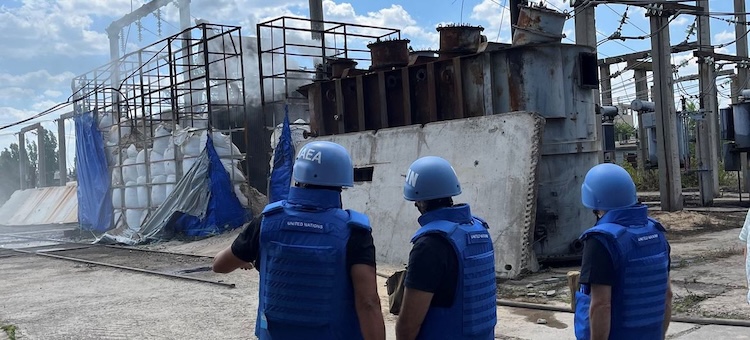By Jaya Ramachandran
VIENNA (IDN) — As the Ukraine war drags on, the International Atomic Energy Agency (IAEA) Director General Rafael Mariano Grossi has expressed concern about the escalating nuclear safety risks. Reiterating the UN-backed IAEA’s commitment to monitoring facilities such as the Khmelnitsky, Rivne and South Ukraine Nuclear Power Plants (NPPs), he described how facilities were performing under extreme conditions.
“The electrical grid’s ability to provide a reliable off-site power supply to Ukrainian NPPs was reduced by damage sustained following military attacks in November and December 2024,” Mr. Grossi told the IAEA Board of Governors. He stressed the ongoing strain on national energy infrastructure, in the face of Russia’s ongoing invasion.
Referring to a drone strike that severely damaged an IAEA vehicle during a routine rotation, the Director General said that direct attacks have complicated the UN agency’s work. Though staff survived this unacceptable attack unharmed, the rear of the vehicle was destroyed. Working in these volatile conditions implies continuous risks.
Of particular concern is the situation at the Zaporizhzhya Nuclear Power Plant (ZNPP), where six reactor units remain in cold shutdown. The facility’s off-site power supply continues to be vulnerable. Mr. Grossi highlighted a recent incident in which ZNPP relied on a single off-site power line after losing its remaining backup, further underscoring the fragility of the plant.
Meanwhile, an attack on the Chernobyl site nearly three weeks ago, which caused significant damage to the protective structure of the 1986 reactor, was also addressed. While no radioactive release occurred, Mr. Grossi stressed that the attack “underlines the persistent risk to nuclear safety during this military conflict”.
He restated the IAEA’s ongoing support for Ukraine: “We are grateful to all 30 donor states and the European Union for their extrabudgetary contributions.” Since November 2024, the Agency has delivered 31 shipments of nuclear safety, security and medical equipment, totalling over €15.6 million in value. He called for continued support for the comprehensive assistance programme.
Iran’s nuclear programme
Mr. Grossi also reported fresh concerns over Iran’s nuclear programme, especially its stockpile of uranium enriched to 60 per cent. Iran remains the only non-nuclear weapon State enriching uranium to this level, raising significant concerns over potential weapons development.
“Iran says it has declared all nuclear material, activities and locations required under its NPT Safeguards Agreement. However, this statement is inconsistent with the Agency’s findings of uranium particles of anthropogenic origin at undeclared locations in Iran,” Mr. Grossi explained.
The Director General emphasised the need for greater transparency, stressing that unresolved safeguards issues must be addressed for Iran’s nuclear activities to be deemed peaceful. He called on Iran to urgently implement the Joint Statement of March 2023 and engage in serious dialogue aimed at resolving outstanding issues.
Fukushima
Mr. Grossi also outlined the IAEA’s broader initiatives, including his recent visit to Japan’s Fukushima Daiichi Nuclear Power Station, where he supervised the collection of water samples related to the ongoing release of ALPS-treated contaminated water — in the wake of the major 2011 meltdown.
“The IAEA has maintained its independent monitoring and analysis efforts, confirming that tritium concentrations in the discharged batches remain far below operational limits,” he noted.
Looking ahead, the Director General highlighted key upcoming initiatives, such as the launch of the Atomic Technology Licensed for Applications at Sea (ATLAS) and the IAEA’s first International Symposium on Artificial Intelligence and Nuclear Energy, which will take place in December 2025.
In view of the rising global demand for energy, Mr. Grossi pointed to the growing role of nuclear power in addressing energy needs. “In the IAEA’s high case scenario, global nuclear electricity generating capacity is seen increasing two and a half times by 2050,” he said. However, the Director General stressed that such growth must be accompanied by public support and a continued commitment to safety. [IDN-InDepthNews | 3 March 2025]
Image: A team of IAEA experts visits Zaporizhzhya Nuclear Power Plant in Ukraine in June 2024. Credit: IAEA


